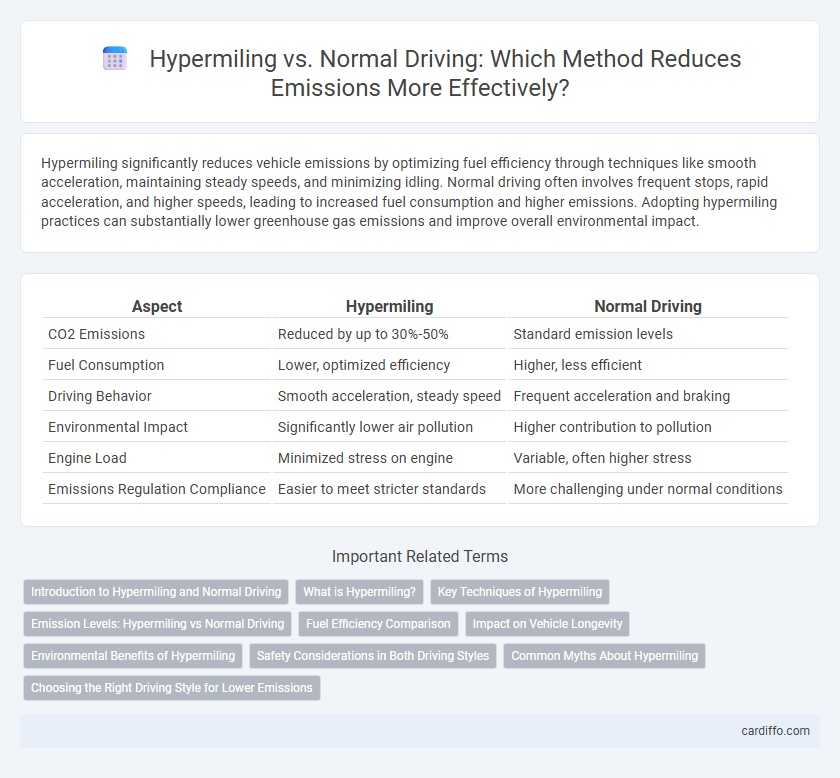Hypermiling significantly reduces vehicle emissions by optimizing fuel efficiency through techniques like smooth acceleration, maintaining steady speeds, and minimizing idling. Normal driving often involves frequent stops, rapid acceleration, and higher speeds, leading to increased fuel consumption and higher emissions. Adopting hypermiling practices can substantially lower greenhouse gas emissions and improve overall environmental impact.
Table of Comparison
| Aspect | Hypermiling | Normal Driving |
|---|---|---|
| CO2 Emissions | Reduced by up to 30%-50% | Standard emission levels |
| Fuel Consumption | Lower, optimized efficiency | Higher, less efficient |
| Driving Behavior | Smooth acceleration, steady speed | Frequent acceleration and braking |
| Environmental Impact | Significantly lower air pollution | Higher contribution to pollution |
| Engine Load | Minimized stress on engine | Variable, often higher stress |
| Emissions Regulation Compliance | Easier to meet stricter standards | More challenging under normal conditions |
Introduction to Hypermiling and Normal Driving
Hypermiling is a driving technique focused on maximizing fuel efficiency and minimizing carbon emissions through smooth acceleration, maintaining steady speeds, and reducing unnecessary idling. Normal driving typically involves conventional acceleration and braking patterns which result in higher fuel consumption and increased greenhouse gas emissions compared to hypermiling. Implementing hypermiling practices can lead to significant reductions in CO2 emissions, contributing to environmental sustainability and lower fuel costs.
What is Hypermiling?
Hypermiling refers to a set of driving techniques aimed at maximizing fuel efficiency and reducing vehicle emissions by minimizing acceleration, maintaining steady speeds, and anticipating traffic flow. This method significantly lowers carbon dioxide (CO2) emissions compared to normal driving habits, which often involve rapid acceleration and frequent braking. By optimizing fuel use, hypermiling contributes to decreased air pollution and supports environmental sustainability efforts.
Key Techniques of Hypermiling
Hypermiling techniques such as smooth acceleration, maintaining steady speeds, and maximizing coasting distance significantly reduce fuel consumption and emissions compared to normal driving. Drivers optimize gear shifting by shifting up early and avoiding RPMs in high ranges, while also minimizing idling time to lower carbon dioxide output. Utilizing advanced methods like drafting carefully behind other vehicles and reducing unnecessary weight further enhances fuel efficiency, making hypermiling a critical strategy for emission reduction.
Emission Levels: Hypermiling vs Normal Driving
Hypermiling techniques can reduce vehicle emissions by optimizing fuel efficiency, often lowering carbon dioxide (CO2) emissions by up to 20% compared to normal driving habits. Normal driving typically involves frequent acceleration and braking, which increases fuel consumption and results in higher levels of nitrogen oxides (NOx) and particulate matter (PM). Data from the Environmental Protection Agency (EPA) indicate that smoother driving patterns like hypermiling contribute significantly to decreased greenhouse gas emissions, promoting cleaner air quality.
Fuel Efficiency Comparison
Hypermiling techniques enhance fuel efficiency by up to 20%, significantly reducing emissions compared to normal driving habits, which typically involve frequent acceleration and braking. By maintaining steady speeds, anticipating traffic flow, and minimizing idling, hypermiling lowers fuel consumption and decreases carbon dioxide output per mile. Studies indicate that adopting hypermiling can lead to substantial reductions in greenhouse gas emissions, making it an effective strategy for environmentally conscious drivers.
Impact on Vehicle Longevity
Hypermiling techniques, such as steady acceleration and maintaining optimal speeds, reduce engine stress and wear, potentially extending vehicle longevity by minimizing mechanical strain and fuel consumption. Normal driving habits often involve frequent acceleration and braking, which increase engine load and accelerate component deterioration, leading to more frequent maintenance. By optimizing driving patterns to reduce emissions and mechanical stress, hypermiling helps preserve engine efficiency and prolongs the overall lifespan of the vehicle.
Environmental Benefits of Hypermiling
Hypermiling significantly reduces vehicle emissions by optimizing fuel efficiency through techniques like smooth acceleration, maintaining steady speeds, and minimizing idling, which lowers carbon dioxide (CO2) output compared to normal driving. Studies demonstrate that hypermiling can cut greenhouse gas emissions by up to 30%, contributing to improved air quality and reduced environmental impact. This reduction in fuel consumption directly lessens the release of pollutants such as nitrogen oxides (NOx) and particulate matter, supporting global efforts to combat climate change and pollution.
Safety Considerations in Both Driving Styles
Hypermiling techniques often require drivers to maintain slower speeds and anticipate traffic flow to enhance fuel efficiency, which can sometimes reduce situational awareness and reaction time in emergency situations. Normal driving practices prioritize consistent speeds and adherence to traffic laws, promoting predictability and safety on the road but typically resulting in higher emissions. Balancing emission reduction goals with road safety involves careful evaluation of driving habits to prevent accidents while optimizing fuel consumption.
Common Myths About Hypermiling
Hypermiling is often misunderstood, with common myths claiming it drastically reduces emissions at the expense of safety or vehicle performance. In reality, smooth acceleration, steady speeds, and minimized idling, core hypermiling techniques, effectively lower carbon dioxide (CO2) emissions compared to typical driving habits without compromising safety. Scientific studies confirm that adopting gradual braking and optimized gear shifts directly reduces fuel consumption and emissions, debunking the misconception that hypermiling involves risky maneuvers or extreme driving conditions.
Choosing the Right Driving Style for Lower Emissions
Hypermiling techniques, such as smooth acceleration and maintaining steady speeds, significantly reduce fuel consumption and carbon emissions compared to normal driving habits. Normal driving often involves rapid acceleration and frequent braking, which increase fuel usage and greenhouse gas output. Selecting hypermiling over conventional driving can lower a vehicle's emissions by up to 30%, contributing to more sustainable transportation choices.
Hypermiling vs Normal Driving Infographic

 cardiffo.com
cardiffo.com